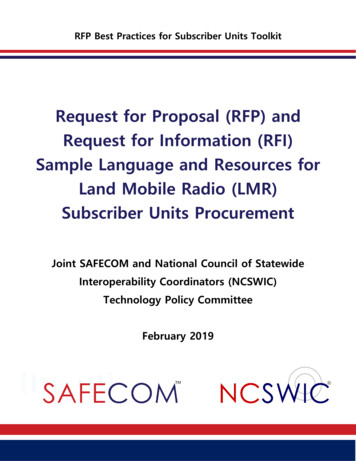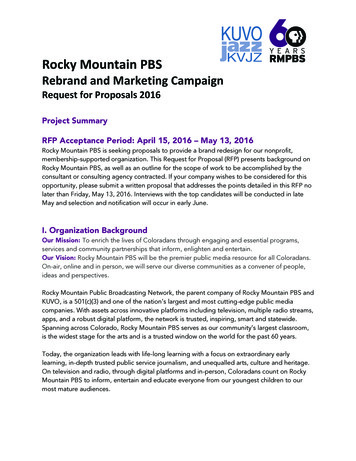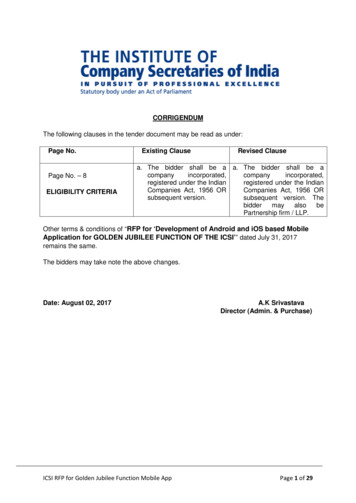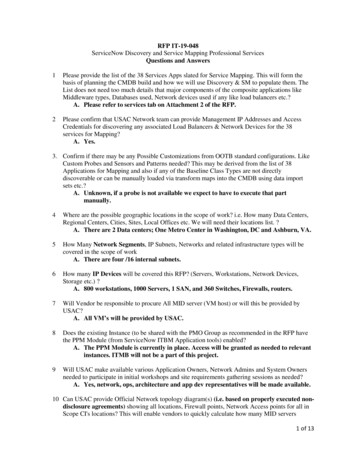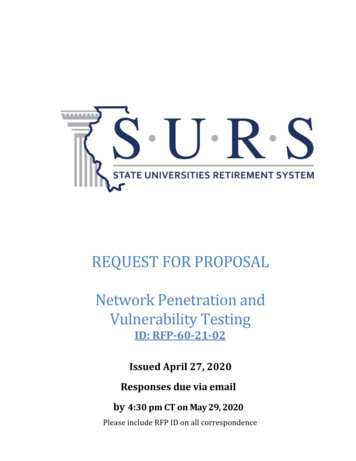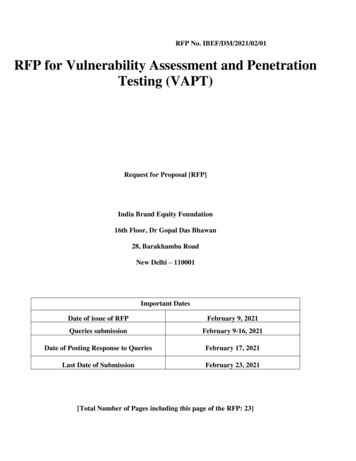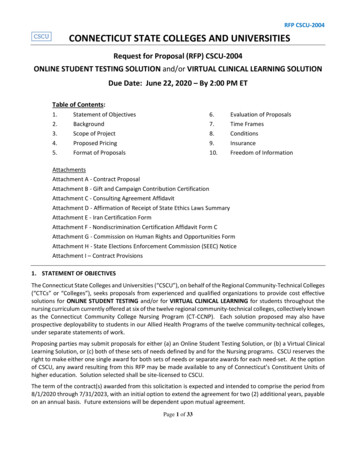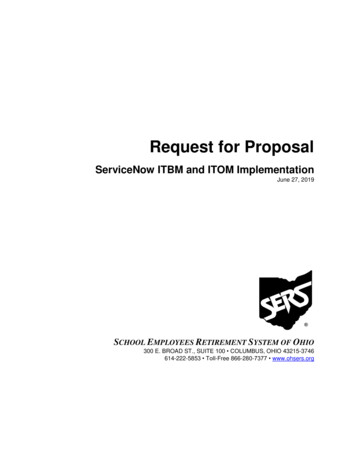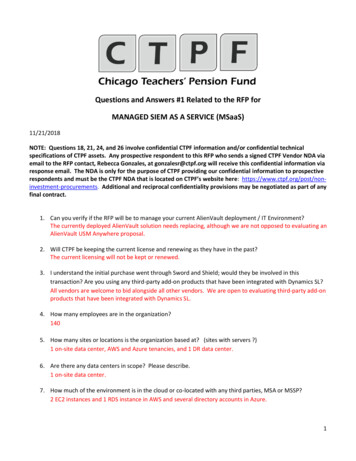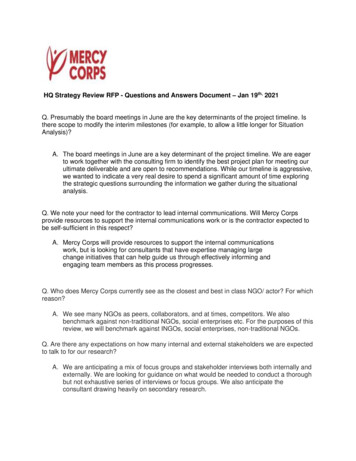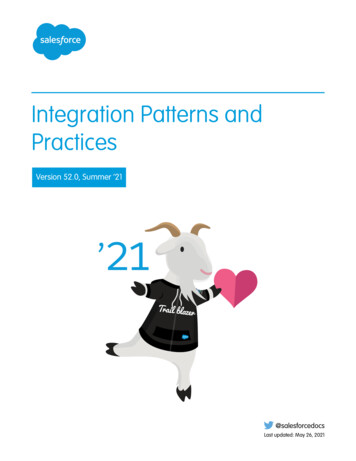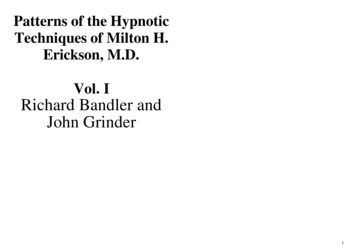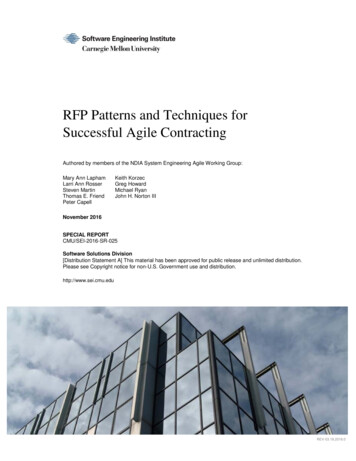
Transcription
RFP Patterns and Techniques forSuccessful Agile ContractingAuthored by members of the NDIA System Engineering Agile Working Group:Mary Ann LaphamLarri Ann RosserSteven MartinThomas E. FriendPeter CapellKeith KorzecGreg HowardMichael RyanJohn H. Norton IIINovember 2016SPECIAL REPORTCMU/SEI-2016-SR-025Software Solutions Division[Distribution Statement A] This material has been approved for public release and unlimited distribution.Please see Copyright notice for non-U.S. Government use and 0
Copyright 2016 Carnegie Mellon UniversityThis material is based upon work funded and supported by the Department of Defense under ContractNo. FA8721-05-C-0003 with Carnegie Mellon University for the operation of the Software Engineering Institute, a federally funded research and development center.Any opinions, findings and conclusions or recommendations expressed in this material are those of theauthor(s) and do not necessarily reflect the views of the United States Department of Defense.References herein to any specific commercial product, process, or service by trade name, trade mark,manufacturer, or otherwise, does not necessarily constitute or imply its endorsement, recommendation,or favoring by Carnegie Mellon University or its Software Engineering Institute.This report was prepared for theSEI Administrative AgentAFLCMC/PZM20 Schilling Circle, Bldg 1305, 3rd floorHanscom AFB, MA 01731-2125NO WARRANTY. THIS CARNEGIE MELLON UNIVERSITY AND SOFTWARE ENGINEERINGINSTITUTE MATERIAL IS FURNISHED ON AN “AS-IS” BASIS. CARNEGIE MELLONUNIVERSITY MAKES NO WARRANTIES OF ANY KIND, EITHER EXPRESSED OR IMPLIED,AS TO ANY MATTER INCLUDING, BUT NOT LIMITED TO, WARRANTY OF FITNESS FORPURPOSE OR MERCHANTABILITY, EXCLUSIVITY, OR RESULTS OBTAINED FROM USEOF THE MATERIAL. CARNEGIE MELLON UNIVERSITY DOES NOT MAKE ANYWARRANTY OF ANY KIND WITH RESPECT TO FREEDOM FROM PATENT, TRADEMARK,OR COPYRIGHT INFRINGEMENT.[Distribution Statement A] This material has been approved for public release and unlimited distribution. Please see Copyright notice for non-US Government use and distribution.Internal use:* Permission to reproduce this material and to prepare derivative works from this materialfor internal use is granted, provided the copyright and “No Warranty” statements are included with allreproductions and derivative works.External use:* This material may be reproduced in its entirety, without modification, and freely distributed in written or electronic form without requesting formal permission. Permission is required for anyother external and/or commercial use. Requests for permission should be directed to the Software Engineering Institute at permission@sei.cmu.edu.* These restrictions do not apply to U.S. government entities.DM-0004062CMU/SEI-2016-SR-025SOFTWARE ENGINEERING INSTITUTE CARNEGIE MELLON UNIVERSITY[Distribution Statement A] This material has been approved for public release and unlimited distribution. Please seeCopyright notice for non-U.S. Government use and distribution.
Table of ContentsAcknowledgmentsvExecutive SummaryviAbstractviii1Introduction1.1 Purpose1.1.1 Rationale1.1.2 Topics Not Included11132Background2.1 Agile Definition2.2 Lean Thinking and Kanban2.3 INCOSE Definition of Agility44553Acquisition Context64RFP Changes4.1 Section C4.1.1 The Statement of Objectives (SOO)4.1.2 Statement of Work (SOW)4.1.3 Reviews in an Agile Environment4.1.4 Key Technical Reviews4.2 Section L4.2.1 Subfactor 1 – Agile Development Process4.2.2 Subfactor 2 – Systems Engineering Practices4.2.3 Subfactor 3 – System Test and Delivery4.3 Section M4.4 CDRLs4.5 Cost Proposal and Schedule Instructions4.6 Negotiation778991216161717171820225Changes in Program Execution5.1 Start-Up (Kickoff)5.2 Measures/Metrics5.3 WBS Discussion5.4 Change Management5.5 Risk Assessment5.6 Development Methodologies5.6.1 The Waterfall Model5.6.2 The Agile Model5.7 Mixing Waterfall and Agile Methodologies5.7.1 The Changing Landscape of Software Acquisitions—Employing Hybrid AgileModels5.7.2 DoDI 5000.02 Facilitates Hybrid Agile Software and Waterfall HardwareDevelopment5.8 Bidder’s 16-SR-025SOFTWARE ENGINEERING INSTITUTE CARNEGIE MELLON UNIVERSITY[Distribution Statement A] This material has been approved for public release and unlimited distribution. Please seeCopyright notice for non-U.S. Government use and distribution.313133i
Appendix A - Agile Fundamentals35Appendix B - Marbach Updated Principles to the Agile Manifesto37Appendix C - Acronyms38Appendix D - Glossary41References43CMU/SEI-2016-SR-025SOFTWARE ENGINEERING INSTITUTE CARNEGIE MELLON UNIVERSITY[Distribution Statement A] This material has been approved for public release and unlimited distribution. Please seeCopyright notice for non-U.S. Government use and distribution.ii
List of FiguresFigure 1:Requirements Moving En Masse Through the Process [Palmquist 2013]10Figure 2:Agile Building Blocks [Palmquist 2013]10Figure 3:Agile Development Pattern (Example 1)11Figure 4:Another View of Reviews in Agile Environment12Figure 5:CDRL Delivery19Figure 6:SW Development MIL-STD 881C Appendix K WBS Breakout (Traditional Waterfall)[PARCA 2016]26Figure 7:Possible Agile SW Development MIL-STD-881C WBS Breakout (Agile Capability-Based)[PARCA 2016]26Figure 8:Engineering V Model28Figure 9:DoD 5000.02 Hybrid Model32Figure 10:The Agile Software Development Lifecycle36CMU/SEI-2016-SR-025SOFTWARE ENGINEERING INSTITUTE CARNEGIE MELLON UNIVERSITY[Distribution Statement A] This material has been approved for public release and unlimited distribution. Please seeCopyright notice for non-U.S. Government use and distribution.iii
List of TablesTable 1:SOO versus SOWTable 2:Example Definition for Adjectival RatingsCMU/SEI-2016-SR-025SOFTWARE ENGINEERING INSTITUTE CARNEGIE MELLON UNIVERSITY[Distribution Statement A] This material has been approved for public release and unlimited distribution. Please seeCopyright notice for non-U.S. Government use and distribution.718iv
AcknowledgmentsTo Dan Ward for answering our call for how F.I.R.E. can support or shape technical reviews.To the author team for sticking with the project and enduring the many meetings to produce thisproduct: Mary Ann Lapham, SEI Keith Korzec, SEI Larri Ann Rosser, Raytheon Intelligence Information and Services Greg Howard, The MITRE Corporation Steven Martin, Space and Missile Systems Center Michael Ryan, BTAS Thomas E. Friend, Agile On Target John H. Norton III, Raytheon Integrated Defense Systems Peter Capell, SEITo our independent reviewers for their insight: Dr. Elizabeth J. Wilson, Raytheon Integrated Defense Systems (Retired) Gari Palmer, Raytheon Integrated Defense Systems William E. Novak, SEIAnd always to Gerald Miller, our unfailingly patient editor.CMU/SEI-2016-SR-025SOFTWARE ENGINEERING INSTITUTE CARNEGIE MELLON UNIVERSITY[Distribution Statement A] This material has been approved for public release and unlimited distribution. Please seeCopyright notice for non-U.S. Government use and distribution.v
Executive SummaryAgile methods have proven effective in rapidly and responsively delivering functionality in commercial environments in which products are developed based on internally identified needs andoffered for sale to multiple uncommitted customers. Agile approaches are becoming more andmore attractive to the Department of Defense (DoD) and other federal agencies in light of recentbudget pressures and a widespread need to bring capabilities to users more quickly than in thepast.To set the stage for this report, the authors turn to the Performance Assessments and Root CauseAnalyses (PARCA) Agile and Earned Value (EV) Desk Guide, which describes the situation:Constantly evolving threats have presented a demand for an acquisition process that is ableto respond quickly to emerging requirements and rapidly changing environments. To address this, the DoD 5000.01 has encouraged the following characteristics in acquisitions:1. Flexibility: tailoring program strategies and oversight2. Responsiveness: rapid integration of advanced technologies3. Innovation: adapt practices that reduce cost and cycle time4. Discipline: use of program baseline parameters as control objectives5. Effective Management: decentralization to the extent practicableThese characteristics have led to an increased focus on flexible development approachesthat include Agile philosophies and integrated program management tools such as EarnedValue Management [PARCA 2016].The TechFAR Handbook further observesIn the Government, digital services projects too often fail to meet user expectations or contain unused or unusable features. Several factors contribute to these outcomes, including theuse of outdated development practices and, in some cases, overly narrow interpretations ofwhat is allowed by acquisition regulations The TechFAR consists of a handbook, whichdiscusses relevant FAR authorities and includes practice tips, sample language, and a compilation of FAR provisions that are relevant to Agile software development [OUSD 2014].Agile methods by design comprise technical and programmatic practices employed to reducewasted effort, decrease bureaucratic overburden, and enhance the productivity and engagement ofdeveloper teams. This document is intended to support the writers of RFPs as they incorporateAgile concepts into programs early in the lifecycle, by providing examples of language that willlay the groundwork for contracts on which programs rely.Specific topics addressed include RFP Section CCMU/SEI-2016-SR-025SOFTWARE ENGINEERING INSTITUTE CARNEGIE MELLON UNIVERSITY[Distribution Statement A] This material has been approved for public release and unlimited distribution. Please seeCopyright notice for non-U.S. Government use and distribution.vi
RFP Section L RFP Section M RFP contract data requirements lists (CDRLs) RFP Cost Proposal and Schedule Instructions Negotiation Start-Up Changes in Program Execution Hybrid Approaches Bidder’s LibraryCMU/SEI-2016-SR-025SOFTWARE ENGINEERING INSTITUTE CARNEGIE MELLON UNIVERSITY[Distribution Statement A] This material has been approved for public release and unlimited distribution. Please seeCopyright notice for non-U.S. Government use and distribution.vii
AbstractIncreasing budget constraints and emphasis on fielding capability faster have led the U.S. Department of Defense (DoD) and other federal entities to pursue the benefits of Agile software development—reduced cycle times, flexibility to adapt to changing conditions and user needs— thatsoftware development practitioners have achieved in the commercial market.This report is written by the National Defense Industrial Association’s System Engineering AgileWorking Group to provide information on request-for-proposal (RFP) patterns and techniques forsuccessful Agile contracting that can and have been used for contracts seeking to employ Agilemethods. This report is intended to support the writers of RFPs in bringing Agile concepts intoprograms at the earliest possible time, providing examples of the kinds of language that will affectthe foundations of contracts on which programs rely.CMU/SEI-2016-SR-025SOFTWARE ENGINEERING INSTITUTE CARNEGIE MELLON UNIVERSITY[Distribution Statement A] This material has been approved for public release and unlimited distribution. Please seeCopyright notice for non-U.S. Government use and distribution.viii
1 IntroductionThis report is authored by the National Defense Industrial Association’s (NDIA) System Engineering Agile Working Group in response to multiple inquiries about what language should beused in a request for proposal (RFP) to enable the use of an Agile approach. The report addressesthe following topics:Section 1provides the introduction, purpose, and topics not included in this discussion.Section 2provides the background including an Agile definition, Lean thinking and Kanban,and the International Council on Systems Engineering (INCOSE) definition ofAgility.Section 3discusses the overall acquisition context for employing Agile methods.Section 4discusses overall RFP changes including Section C (statement of objectives [SOO]or statement of work [SOW], reviews in an Agile environment, key technicalreviews); Section L; Section M; contract data requirements lists (CDRLs); costproposal and schedule instructions; negotiation; and start-up.Section 5discusses potential changes in program execution that will be encountered whenemploying Agile concepts including measures and metrics, work breakdownschedules (WBS), change management, risk assessment, and hybrid approaches.1.1 PurposeThis report provides guidance on the language of government-contract RFPs to assist RFP authorsin supporting agility in government systems acquisitions. “Agile methods” comprise those technical and programmatic practices that are employed to conscientiously be responsive to change,improve quality and fit for purpose, reduce wasted effort, decrease bureaucratic overburden onprograms, and enhance the productivity and engagement of developer teams. This report is intended to support the writers of RFPs in incorporating Agile concepts into programs early in thelifecycle through various elements of the RFP process.1.1.1RationaleThe government is becoming increasingly aware that the traditional methods of RFP and contractdevelopment that are typically employed are not well suited to provide a quickly fielded capability based on an iterative or Agile development approach. Routinely, an RFP is formulated arounda known solution with a majority of the requirements already identified. As in the past, the developers and acquirers follow the processes laid out in directed “best practices” such as the DoD5000 series. Also like so many programs before, the results are often less than expected, costmuch more, and are fielded years later than needed [GAO 2008].Thus, a modified approach for the acquisition process is needed. Instead of contracting for an“end-to-end” system, segments of the government recently began following the lead of the privatesector by acquiring capabilities that build on one another to eventually create the complete systemCMU/SEI-2016-SR-025SOFTWARE ENGINEERING INSTITUTE CARNEGIE MELLON UNIVERSITY[Distribution Statement A] This material has been approved for public release and unlimited distribution. Please seeCopyright notice for non-U.S. Government use and distribution.1
incrementally. The challenges with this approach are in defining the scope (SOO and SOW requirements), assessing the offer (evaluation criteria), evaluating progress (milestones and earnedvalue [EV]), and confirming completion (sell-off criteria).Confusion often occurs when the program office tries to interpret iterative activities relative to thetraditional DoD acquisition lifecycle framework. There seems to be a common misunderstandingthat the development methodology must mirror the acquisition lifecycle [Lapham 2014]. Problems occur when trying to overlay “traditional” acquisition milestone events directly atop development methodologies that use iterative work units, without understanding the relationship amongthe work units and the milestone events. This can be even more complex if Agile software methodologies are being used to develop a system that includes significant specialized hardware (e.g.,acquisition of a satellite, ship, plane, or the like.). Many of these are issues that can be addressedby carefully writing an RFP that enables the government to take full advantage of the benefits thatan Agile acquisition offers [Lapham 2014].Agile or iterative system developments are based on collaboration between the contractor and customer. The acquirers are a part of the team rather than just a compliance organization. Without direct involvement of the system’s intended users or knowledgeable surrogates (program management office [PMO] members or appointed contractor resources), early validation of the directionof the implementation is more difficult than necessary to achieve. This early validation is essentialto ensure that iterative development proceeds in a stable manner, based on layer after layer ofevolving, useful functionality. Some programs may refer to these evolving layers as “threads,”“releases,” “builds,” “iterations,” “spirals,” “slices,” and other similar terms [Lapham 2014].There isn’t only one approach to specifying contractual terms to incentivize proposal of productive Agile approaches. Because there isn’t a single definition of “Agile,” saying “wewant a contractor to use Agile methods” isn’t useful. Being clear about the relationship expected without inappropriately constraining the “how” things get done is the balance toseek.We have seen every DoD contract type used at one time or another for programs using Agile. Conditions under which one contract type or another works well are still anecdotal.Firm Fixed Price seems to be the most difficult to use to build the collaborative relationshipsthat are the hallmark of effective Agile programs [Foreman 2014].Like the system under development, the RFP must address technical evaluations that are incremental. Similarly, plans, documentation, and other CDRLs are also developed incrementally overthe entire life of the program. While different from the traditional acquisition world, this methodhas the advantage of providing documentation of the system “as built” rather than “as designed.”This approach allows the government to take advantage of technical advances, changing operational environments, and/or requirements, as detailed design decisions are typically made closer totheir implementation versus all up front. Furthermore, using as-built documentation removes anyadditional burden to the maintenance and logistics community that may come from using as-designed documentation.Since the system is intended to evolve over the duration of the contract, the RFP must include thedefinition of success, especially if it used for incentive fees or progress payments to the developer.CMU/SEI-2016-SR-025SOFTWARE ENGINEERING INSTITUTE CARNEGIE MELLON UNIVERSITY[Distribution Statement A] This material has been approved for public release and unlimited distribution. Please seeCopyright notice for non-U.S. Government use and distribution.2
As a principle, Agile welcomes changing requirements, even late in development. Thus, a clearplan on how to deal with the inevitable changes should be included in responses to an RFP toavoid the need to renegotiate the contract when issues arise. Likewise, it is advisable to addressand document the government process to de-scope lower priority features and re-prioritize remaining features in response to new or changed requirements.Finally, the RFP must include mechanisms to give acquirers real-time insight into the capabilitiesto be delivered, metrics, plans, specifications, schedules, and the like.1.1.2Topics Not IncludedThe authors have deliberately avoided including contractual language that could be “cut andpasted” into an RFP and convey a preference for one Agile methodology over any other.In addition, discussion of specific program work plans or tasks, Rapid Acquisition, and hardwareonly buys are not included.CMU/SEI-2016-SR-025SOFTWARE ENGINEERING INSTITUTE CARNEGIE MELLON UNIVERSITY[Distribution Statement A] This material has been approved for public release and unlimited distribution. Please seeCopyright notice for non-U.S. Government use and distribution.3
2 BackgroundTraditional and Agile development both have a place in modern systems acquisition. Some general characteristics of programs more suited to each development approach are provided below.Keep in mind that these are generalities and there may be instances where a particular approachcan be used successfully on a program that does not strictly conform to the characteristics listedfor that approach. (For
5.7.1 The Changing Landscape of Software Acquisitions—Employing Hybrid Agile Models 31 5.7.2 DoDI 5000.02 Facilitates Hybrid Agile Software and Waterfall Hardwa
